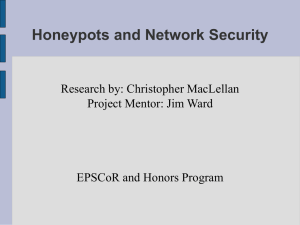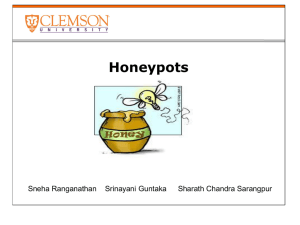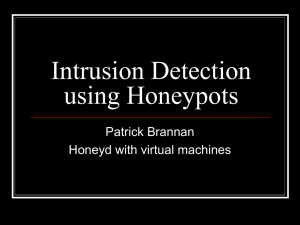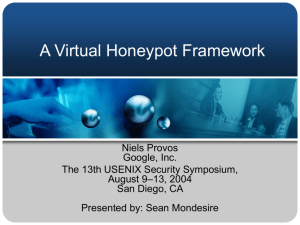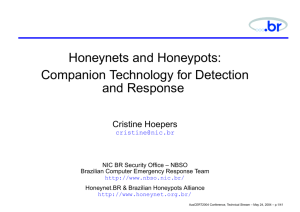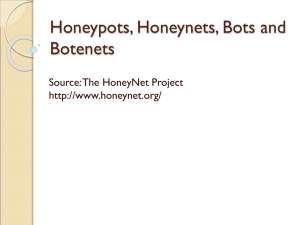HoneyPots
advertisement
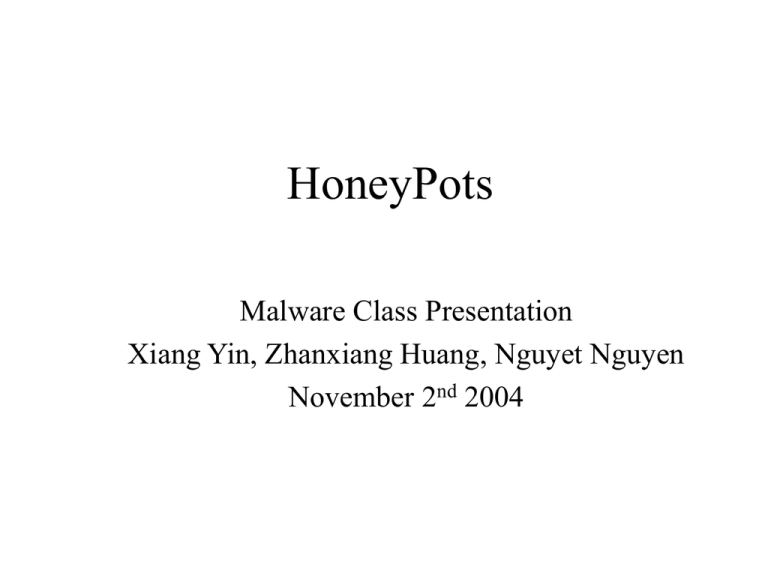
HoneyPots Malware Class Presentation Xiang Yin, Zhanxiang Huang, Nguyet Nguyen November 2nd 2004 Problems Why? Problems (2) • The Internet security is hard – New attacks every day – Our computers are static targets • What should we do? • The more you know about your enemy, the better you can protect yourself • Fake target? Solutions? Air Attack Real A Detected…. Fake Honeypots? • Fake Target • Collect Infomation Agenda • • • • Honeypots: an whitepaper Honeyd Honeynet Discussion History of Honeypots • 1990/1991 The Cuckoo’s Egg and Evening with Berferd • 1997 - Deception Toolkit • 1998 - CyberCop Sting • 1998 - NetFacade (and Snort) • 1998 - BackOfficer Friendly • 1999 - Formation of the Honeynet Project • 2001 - Worms captured Definition A honeypot is an information system resource whose value lies in unauthorized or illicit use of that resource. • Has no production value; anything going to/from a honeypot is likely a probe, attack or compromise • Used for monitoring, detecting and analyzing attacks • Does not solve a specific problem. Instead, they are a highly flexible tool with different applications to security. Classification • By level of interaction • High • Low • Middle? • By Implementation • Virtual • Physical • By purpose • Production • Research Level of Interaction • Low Interaction • • • • Simulates some aspects of the system Easy to deploy, minimal risk Limited Information Honeyd • High Interaction • • • • Simulates all aspects of the OS: real systems Can be compromised completely, higher risk More Information Honeynet Level of Interaction Low Fake Daemon Medium Operating system Disk High Other local resource Physical V.S. Virtual Honeypots • Two types – Physical • Real machines • Own IP Addresses • Often high-interactive – Virtual • Simulated by other machines that: – Respond to the traffic sent to the honeypots – May simulate a lot of (different) virtual honeypots at the same time How do HPs work? Prevent Detect Response Monitor No connection Attack Data HoneyPot A Gateway Attackers Production HPs: Protect the systems • Prevention • Keeping the bad guys out • not effective prevention mechanisms. • Deception, Deterence, Decoys do NOT work against automated attacks: worms, auto-rooters, mass-rooters • Detection • Detecting the burglar when he breaks in. • Great work • Response • Can easily be pulled offline • Little to no data pollution Research HPs: gathering information • Collect compact amounts of high value information • Discover new Tools and Tactics • Understand Motives, Behavior, and Organization • Develop Analysis and Forensic Skills • HONEYNET? Building your HoneyPots • Specifying Goals • Selecting the implementation strategies • Types, Number, Locations and Deployment • • • • Implementing Data Capture Logging and managing data Mitigating Risk Mitigating Fingerprint Location of Honeypots • In front of the firewall • Demilitarized Zone • Behind the firewall (Intranet) Capturing Information • Host based: • Keystrokes • Syslog • Network based: • Firewall • Sniffer • IP not resolve name Logging and Managing Data • Logging architecture • Managing data Maintaining Honeypots • • • • Detection and Alert Response Data Analysis Update Honeyd: A Virtual Honeypot Framework By Zhanxiang Huang November 2nd, 2004 Physical V.S. Virtual Honeypots PH (Real machines, NICs, typically highinteraction) High maintenance cost; Impractical for large address spaces; VH (Simulated by other machines) Multiple virtual services and VMs on one machine; Typically it only simulate network level interactions, but still able to capture intrusion attempts; What is Honeyd? Honeyd: A virtual honeypot application, which allows us to create thousands of IP addresses with virtual machines and corresponding network services. Written by Neil Provos available at http://www.honeyd.org/ What can honeyd do? Simulates operating systems at TCP/IP stack level, supporting TCP/UDP/ICMP; Support arbitrary services; Simulate arbitrary network topologies; Support tunneling and redirecting net traffic; Illustration Simple How it attracts worms? Honey!~ But technically they need to advertise themselves; Three methods: Create special routes; Proxy ARP; Network tunnels. How it works? Network routing Configuration DataBase Personality Engine Packet Dispatcher routing TCP UDP Services ICMP Why Personality Engine? To fool fingerprinting tools Uses fingerprint databases by Nmap, for TCP, UDP Xprobe, for ICMP Introduces changes to the headers of every outgoing packet before sent to the network Why Routing topology? Simulates virtual network topologies; Some honeypots are also configured as routers Latency and loss rate for each edge is configured; Support network tunneling and traffic redirection; Why Redirect Connection? :D How to Configure? Each virtual honeypot is configured with a template. Commands: Create: Creates a new template Set: Assign personality (fingerprint database) to a template Specify default behavior of network protocols Add: Specify available services Block: All packets dropped Reset: All ports closed by default Open: All ports open by default Proxy: Used for connection forwarding Bind: Assign template to specific IP address Show Time!~ Real Demo by Zhanxiang This simplified configuration was used with attract the MSBlast worm over the Internet: create default set default personality "Windows XPPro" add default tcp port 135 open add default tcp port 4444 "/bin/shscripts/WormCatcher.sh $ipsrc $ipdst" set default tcp action block set default udp action block Applications Worm detection and blocking Combine with automated its postprocessing tools, like NIDS signature generation tool honeycomb[1]; Network decoys Spam Prevention Simulation Results of Anti-Worm How real is it? Traceroute to a virtual host Path of the hosts according to the configuration Latency measured double the one specified Correct because packets have to travel each link twice Fingerprinting to the Router personality Nmap and Xprobe detected Cisco router NetBSD personality Nmap detected NetBSD Xprobe listed a number of possibilities including NetBSD Risks? Some smart worms may wake up! The honeyd will be snubbed; We might become accessary if our honeyd is compromised and used as bounce; Are attackers nuts? (From securityfocus paper on Sep. 28, 2004 : “Defeating Honeypots: Network Issues”, by Laurent Oudot and Thorsten Holz) http://www.securityfocus.com/infocus/1803 In theory: Remote actions Local actions Cloaking issues Breaking the Matrix Practical ways: layer 2 Sebek-based Honeypots Fake AP Bait and Switch Honeypots Questions? Honeynet By Xiang Yin November 2nd, 2004 What is a Honeynet • High-interaction honeypot designed to: – capture in-depth information – learn who would like to use your system without your permission for their own ends • Its an architecture, not a product or software. • Populate with live systems. • Can look like an actual production system What is a Honeynet • Once compromised, data is collected to learn the tools, tactics, and motives of the blackhat community. • Information has different value to different organizations. – Learn vulnerabilities – Develop response plans What’s The Difference? • Honeypots use known vulnerabilities to lure attack. – Configure a single system with special software or system emulations – Want to find out actively who is attacking the system • Honeynets are networks open to attack – Often use default installations of system software – Behind a firewall – Rather they mess up the Honeynet than your production system How it works • A highly controlled network where every packet entering or leaving is monitored, captured, and analyzed. • Any traffic entering or leaving the Honeynet is suspect by nature. Diagram of Honeynet Diagram of Honeynet Data Control • Containment of activity – Mitigate risks – Freedom vs. risk • Multiple mechanisms – layers – Counting outbound connections – Intrusion prevention gateways – Bandwidth restrictions • Fail closed! • Minimize risk, but not eliminate! Data Control Data Capture • This is the reason for setting up a honeynet. • Hidden kernel module that captures all activity – monitoring and logging • Challenge: encryption – Activities over encrypted channels (IPSec, SSH, SSL, etc) • Multiple layers of data capture – Firewall layer, network layer, system layer • Minimize the ability of attackers to detect – Make as few modifications as possible – Store data on a secured remote system – Also, reduce risk but not eliminate! Data Analysis • All activity within Honeynet is suspicious • 30 minutes of blackhat activity is about 30 to 40 work hours of data analysis • Less than 10 MB of logging per 24 hours is typical. Data Collection Honeynet – Gen I Honeynet – Gen I • Counts the number of outbound connections. • Systems initiate a certain number of outbound connections and then block any further links once the limit is met. • Useful for blocking denial of service attacks scans, or other malicious activity • But, gives attacker more room to attack. Honeynet – Gen II Honeynet – Gen II • Layer-two bridging device (called the honeynet sensor) isolates and contains systems in the honeynet. • Easier to Deploy – Both Data Control and Data Capture on the same system. • Harder to Detect – Identify activity as opposed to counting connections. – Modify packets instead of blocking. Data Control – Gen II • Implemented on gateway • Connection counting (with IPTables) SCALE="day" TCPRATE="15" UDPRATE="20" ICMPRATE="50" OTHERRATE="15" • NIPS (Network Intrusion Prevention System) – Works with only known attacks – Modify and disable detected outbound attacks instead of blocking them – Snort-inline Data Control - Snort-Inline alert tcp $EXTERNAL_NET any -> $HOME_NET 53 (msg:"DNS EXPLOIT named";flags: A+; content:"|CD80 E8D7 FFFFFF|/bin/sh"; replace:"|0000 E8D7 FFFFFF|/ben/sh";) Data capture elements • Honeynet Project has developed kernel modules to insert in target systems. • These capture all the attacker's activities, such as encrypted keystrokes. • The IDS gateway captures all the data and dump the data generated by the attackers without letting attacker know. • multiple layers of data capture help ensure that they gain a clear perspective of the attacker's activities. Data capture elements • Layer 1: the firewall log – packet-filtering mechanism to block outbound connections once a connection limit is met. • Layer 2: network traffic – The IDS gateway that identifies and blocks attacks passively sniffs every packet and its full payload on the network. • layer 3: system activity – Capturing the attacker's keystrokes and activity on the system. Virtual Honeynets • All the elements of a Honeynet combined on a single physical system. Accomplished by running multiple instances of operating systems simultaneously. Examples include VMware and User Mode Linux. Virtual Honeynets can support both GenI and GenII technologies. Issues • High complexity. – Require extensive resources and manpower to properly maintain. • High risk – Detection and anti-honeynet technologies have been introduced. – Can be used to attack or harm other non-Honeynet systems. • Legal issues – Privacy, Entrapment, Liability Honeypots’ Issues Discussion Honeypot Advantages • High Data Value • Small Data • Low Resource Cost • Weak or Retired system • Simple Concept, Flexible Implementation • Return on Investment • Proof of Effectiveness • Catch new attacks Disadvantages • Narrow Field of View • Fingerprinting • Risks? • If being detected? • If being compromised? • If being mis-configured? Mitigrating Risks? • Being Detected? • Anyway honeypots can be detected • Modifying is a good solution, but not perfect • Fingerprinting? • Being Exploited? Building Honeypots for specific purpose? • Bigger fish Specific trap? Legal Issues • Privacy • No single statue concerning privacy – Electronic Communication Privacy Act – Federal Wiretap Statute – The Pen/Trap Statute • Entrapment • Used only to defendant to avoid conviction • Applies only to law enforcement? • Liability • If a Honeynet system is used to attack or damage other nonhoneynet system? More Information about Legal Issues • Computer Crime Section • E-Mail: anthony.teelucksingh@usdoj.gov • Computer Crime Section’s Web page: Conclusion • Honeypots are not a solution, they are a flexible tool with different applications to security. • Primary value in detection and information gathering. • Just the beginning for honeypots. Worm propagation speed sim Simulate worm spreading Parameters i(t): Fraction of infected hosts s(t): Fraction of susceptible hosts r(t): Fraction of immunized hosts β: Worm contact rate γ: Immunization rate Worm propagation formulas ds/dt = − β * i(t) *s(t) di/dt = βi * (t) * s(t) − γ * i(t) dr/dt = γ * i(t)
